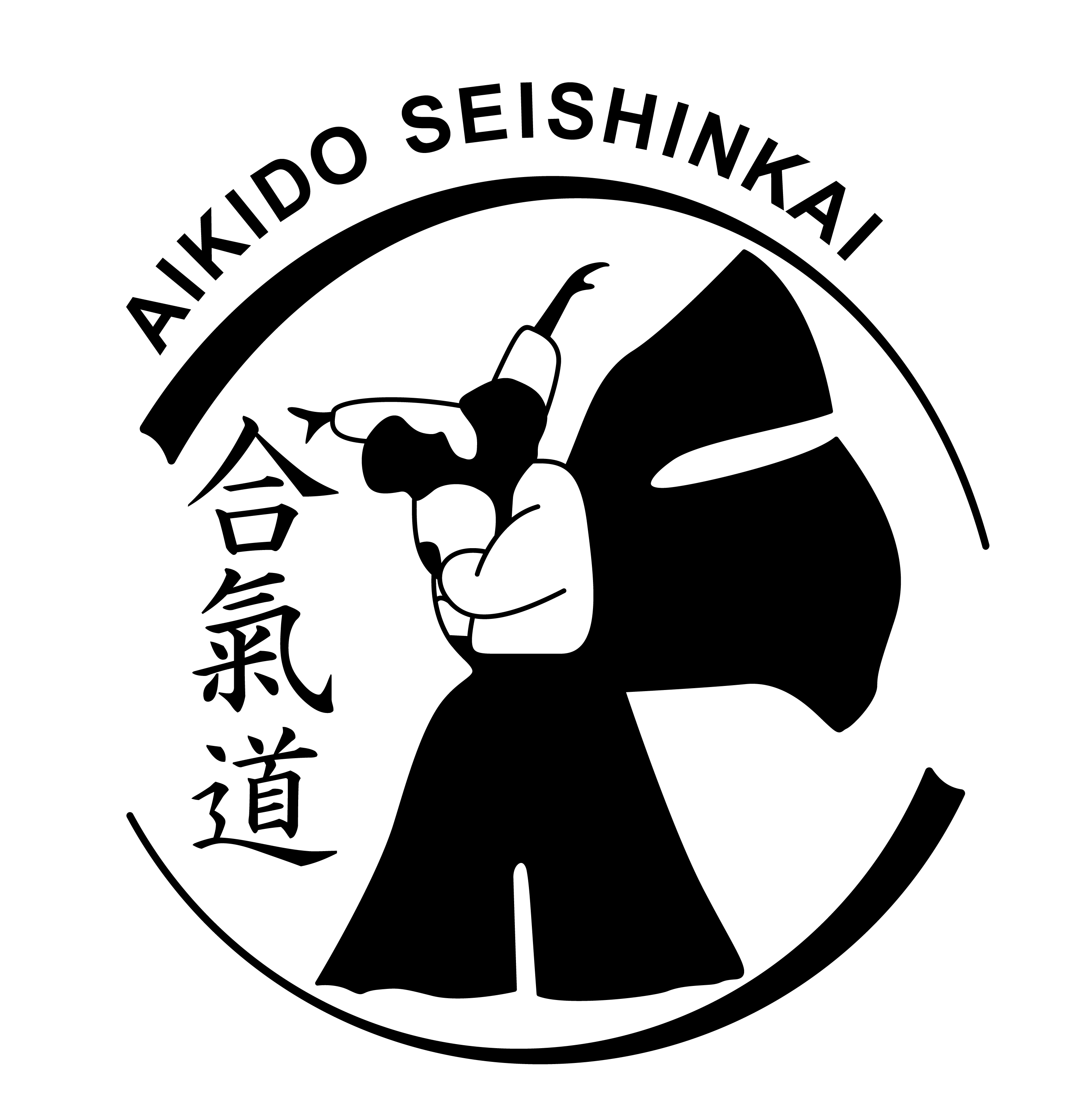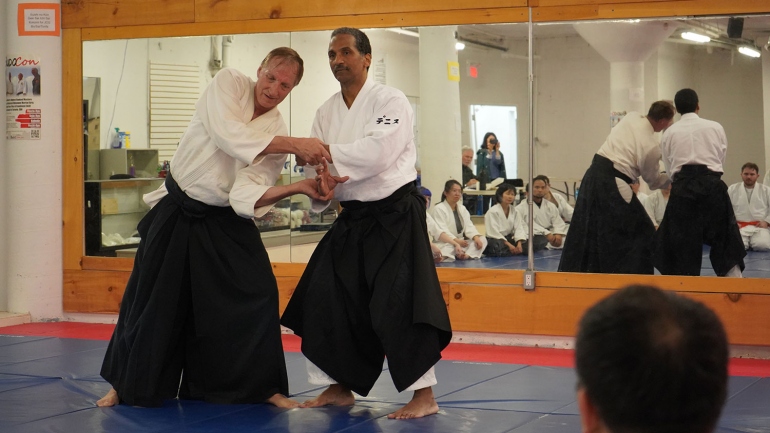Makoto Ohtsu (7 th Dan), Aikido Showa Dojo
Nagoya, Japan
Aikido is a modern Japanese martial art based on the spiritual foundation of harmony, love and
peace. Its objective is to defend oneself when attacked, without harming the attacker. It is a
physical art of “harmonious persuasion” that believes violence is wrong and futile.
In the following, I will discuss how this Aikido approach may be used in resolving conflict. In so
doing, I will first introduce Aikido, with emphasis on its spiritual foundation.
- Aikido: Master Ueshiba’s Spirit-based Modern Martial Art
According to its founder, Master Ueshiba, Aikido consists of three elements. They are “shin
(heart)”, “ki (mind and vital energy)” and “tai (body)”. The relationship among these three
concepts is the following: Shin represents the spiritual side and tai represents the physical side of
Aikido, while ki connects the two to create energy to execute Aikido techniques. Thus, ki has
both spiritual aspect (mind) and physical aspect (vital energy).
Among the three elements of Aikido, tai or body is easy to understand. It means strength of the
body as well as the speed of body movements which are crucially important in Aikido as well as
in any other martial art and competitive sports in general.
The first step of Aikido training, therefore, is physical, that is, the training of strong and flexible
muscles and smooth body movements, especially footwork. It is even desirable that one has done
a fair amount of training to develop strong bones and muscles before undertaking Aikido. Then,
the learning of the specific techniques follows. For that purpose, the original syllabus was
created by the founder after extensive study of various classical martial arts beginning with
Kitoryu Jujutsu and ending with Daitoryu Jujutsu. He called this formative stage of Aikido
“physical Aikido”, or “Aiki Jujutsu”.
The second element of Aikido is shin or heart. The founder starts from the religion-based
conviction that shin or the heart of Aikido has to be love. This is so because the heart of the
“Supreme God of the Universe” is love and Aikido was created by this God. The love in Aikido
originates from the love of the Supreme God to human beings. This spirit of “love in your heart”
is what makes Aikido unique among various martial arts.
As I understand, the Founder’s concept of love is a vertical or one-way loving (from the God to
human beings) not a horizontal or two-way loving (between the God and human beings). This
type of love may be more appropriately called “benevolence”.
In Aikido, as a practical martial art, you have to put yourself in the vertical, not horizontal,
relationship with regard to your opponent (enemy or attacker). You have to be benevolent to
him/her; you are not supposed to destroy or even hurt your opponent. Rather, you are expected to
lead him (her) to his (her) goodness which is gifted by the God to begin with.
The underlying philosophy is that human beings are an artifact of the Supreme God; therefore, to
destroy a human being, even though he/she is your enemy, is against the will of the God, and
therefore is an act of polluting which is the worst “sin” in Shinto. Instead, mending his/her mind,
an act of purification, is what the God wants.
It is important to note here that the God can afford to be benevolent because “he” is almighty.
Likewise, the precondition to be benevolent in Aikido as a martial art is to be almighty, or at
least have a combined physical and technical superiority over one’s opponent to defend oneself
over any attack by the opponent(s). The Founder had reached this stage before he started to
advocate the “spirit-first” Aikido. Those who have not achieved that high level of proficiency,
have to excel in physical Aikido first.
The third element of Aikido is ki, the central component of Aikido created by the Founder. While
body and heart provide the foundation upon which Aikido is built, ki is a more operational
concept which makes Aikido an effective martial art. Also, dual or even multi-dimensional
nature of ki makes its understanding very difficult.
As mentioned before, ki has both a spiritual aspect (mind) and a physical aspect (vital energy).
Between the two, there is a one-way relationship in that mind leads the body, not the other way
around, another conviction the Founder learned from Oomoto-Kyo religion. The Aikido mind is
derived from shin or heart and Aikido vital energy is derived from tai or body. By combining
these two elements, spirit-based Aikido (which the founder called “TakeMusuAiki”) becomes far
more effective than physical Aikido.
As the mind is derived from the heart, the mind of Aikido is love-based. Specifically, the overall
state of mind in Aikido is “harmony”, a Shinto-based concept. This contrasts with that of
aggression, or urge to win in competitive sports, including other martial arts. In competitive
sports, you do both attacking and defending in order to win the game. There is no place for
harmony with the opponent; you either win or lose the game.
With regard to the physical aspect of ki or vital energy, as I mentioned before, it does not operate
independently; rather it works in conjunction with (or follows) the spiritual ki or mind. The
Founder refers to the four stages of ki usage: ki-gamae (mind-setting), ki-musubi (mind-joining),
ki-no-nagare (mind-leading), and ki-osame (mind-sheathing).
At the mind-setting stage, you must set your mind so that you feel a sense of identity with the
universe, or heaven. Your ki (vital energy) is produced out of the breathing, or exhaling and
inhaling of ki (air) of the universe. More specifically, in order to generate ki, you do deep
breathing, feel the breathing of the universe, collect and inhale the whole breath of the universe,
and then exhale. This way you can adapt your breathing to the breathing of the universe. By
repeating this deep breathing several times, you can absorb the vital energy of the universe.
Thus, the “unity of mind and body” is achieved so that you are ready to move as freely as you
wish.
When you face your opponent, your mind tends to become aggressive or defensive against the
opponent’s attack, but the harmonious meeting of two minds is needed here. At this mind-joining
stage, you do not simply join your mind with the mind of your opponent. Instead, you feel as if
you stand in the middle of the universe and absorb your opponent’s mind into yourself.
When the opponent initiates an attack, the physical contact of joining takes place. You do not
strike back or otherwise block the force of the attack. For example, when your opponent attempts
to punch you in the abdomen, you do not make any move to protect your mid-section. Instead,
you make your target open to his/her attack. By letting him/her commit the punch to your
abdomen, you can step forward, slightly off the line of attack, and move your arm to the same
direction as that of the opponent. This way you join with your opponent mentally and physically.
By joining, you are ready to control your opponent’s mind and therefore body as well at next
stage.
Then, at the mind-leading stage, you have to lead your opponent (his/her mind and body) in a
circular way. This circle is a three-dimensional concept, like a ball where there is no edge.
Physically, circular movement includes horizontal circle, vertical circle and all types of diagonal
circles. Circular movement is important because it ensures continuous flow of energy.
At the end of this stage, your opponent will be off balance and you are ready to execute your
technique (throw or pin). In so doing, you are preparing to put your active mind to rest by
discharging energy.
Next (and the last) is the mind-sheathing stage. You concentrate your mind into your tanden (one
point in the abdomen) by deep breathing. This way you can collect discharged energy and store it
in your tanden. Please note that tanden is a Zen, not Shinto, terminology. But I incorporate it
here, as the Founder did use it, if not frequently.
Although the Founder’s reasoning involving ki is sometimes difficult to follow, I do believe in
his basic thesis that mind leads the body and that ki energy is real, not imaginary. Therefore, by
learning how to obtain and use ki you can increase the effectiveness of your techniques. Also, to
the extent that ki (mind) derives from shin (heart), then, practicing Aikido with gentle heart
improves your skills.
Above is a brief summary of Aikido. Here, a few comments are in order with regard to the
evolution of Aikido. Following the footsteps of the Founder, there are four stages in the
development of Aikido which also applies to the development of individual Aikidoists. They are
1) physical Aikido (~1935), 2) TakemusuAiki or spirit-based Aikido (~1942), 3) Aikido as a
means to “purify” Japan and the world (~1957), and 4) Aikido as a means to achieve world peace
(1957~). Today, these four stages of development may be viewed as the four levels or layers of
Aikido.
The relationship among these four levels is that each level forms the basis for the next level. For
example, physical Aikido is the basis for spirit-based Aikido. Also, in order to contribute to the
achievement of world peace through Aikido, one must train physical Aikido, spirit-based Aikido
and off-the-mat behavior to be a good citizen to purify oneself as well as others. Also, there is a
big jump from level two to three. While at levels one and two the perfection of Aikido is the
goal, at levels three and four Aikido has become a means to achieve social and international
goals of harmony and peace, respectively.




